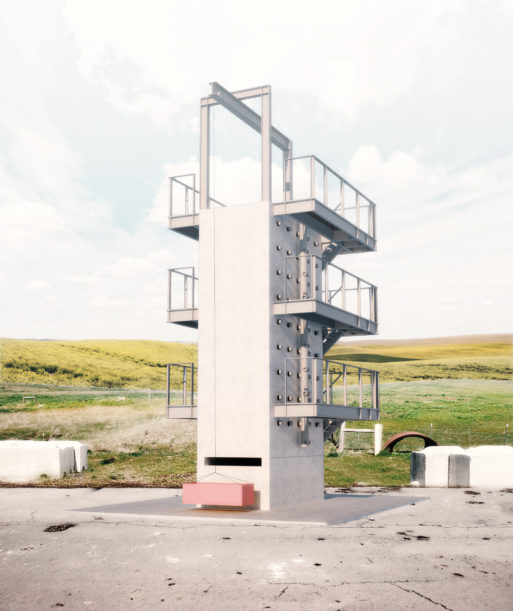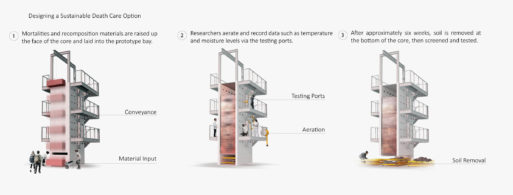
Urban Death Project concept image
(Credit: wired.com)
Architect Katrina Spade may be the first person to offer an alternative to burial or cremation of human remains: composting. It has been true since time immemorial that our bodies come from and return to the earth. We are what we eat, drink and breathe. With the Urban Death Project, Spade has designed a system whereby human remains can literally return to earth in the middle of a city. Part funeral home, part memorial, part public park, her “recomposition” center is designed to naturally accelerate the decomposition process. It turns human remains in a loam-like compost in about four to six weeks.
It works like this. The central concrete structure is three stories high, comprising an internal landscape of remains separated by 3 feet of wood chip mulch. There are holes in the sides of the structure to aerate the material. This increases the activity of microorganisms, which speeds up the decomposition process. There is also a loading bay at ground level to raise a casket up to the third floor, which is a memorial place where families can hold a funeral service or other ritual. There is also a ramp from the ground to the top level, which affords the opportunity for a mindful procession with the casket. The top floor also holds a 6-by-10 foot bay, where the shrouded body sits. During the memorial, mourners can toss wood chips instead of flowers as the mechanism lowers the body of their loved one into the structure.

Urban Death Project concept image
(Credit: wired.com)
As the body slowly descends and decomposes, it transforms into material that is no longer human. Instead, it is the organic stuff that helps plants grow. At the very bottom of the recomposition structure, the workers gather the coarse loam and sift through it, looking for small items such as metal dental fillings. They then process the material by natural means into fertile compost.
The Urban Death Project sounds like a reasonable idea, but will it work? And will the public be interested in using it? Well, Spade is set to test out her extensive research in partnership with Lynne Carpenter-Boggs, a soil scientist at Washington State University. WSU already has a systematic decomposition process in place for the animals that die within their agricultural department. But they’ve never tested a vertical system such as the one Spade has designed. On-site trials are beginning next year.

Interior view of the Steven Holl Chapel of St. Ignatius
(Credit: pcad.lib.washington.edu)
As for public appeal, Spade suggests that this concept need not be distasteful or macabre in any way. Rather, she envisions different places and cultures creating their own aesthetic take. In this article, Spade is cited referencing two existing sites — Steven Holl’s Chapel of St. Ignatius on the Seattle University campus, and Peter Zumthor’s Therme Vals. The latter is a Swiss spa built over thermal springs. Something similar might encompass the vertical tower or influence the aesthetics of the ritual room at the top.
Both burial and cremation come at a high environmental and financial cost to the living. As Spade’s research continues, we may find that “recomposition” is a viable alternative especially in densely populated urban areas.

 Urban Death Project Composts Human Remains
Urban Death Project Composts Human Remains


 Forest Bathing Eases Grief by Soaking in Nature
Forest Bathing Eases Grief by Soaking in Nature
 The Spiritual Symbolism of Cardinals
The Spiritual Symbolism of Cardinals
 Meaning-Focused Grief Therapy: Imaginal Dialogues with the Deceased
Meaning-Focused Grief Therapy: Imaginal Dialogues with the Deceased















very interested in this process
Report this comment
It is still in the beginning, but I’m not sure about the compost idea. I read that someone compared it to mass graves.
But, the biggest flaw I see is that God is not in the design. Where is eternal life explained, because it’s not.
Katerina Spade said during TED that religious affiliation has declined. But, God is God.
Perhaps, for people who don’t believe in God? I still would hope that when a loved one dies that people are reminded of God’s love. People do change their minds about religion and God.
Report this comment
I’m interested
Report this comment
Hi Jeffrey,
Yes more states are in line to legalize this method. Depending on where you live this will be a disposition method coming to your state (or may have already been legalized) soon! You are not alone. There are already 800 people in line to be composted in their future.
Thanks for visiting us.
Report this comment